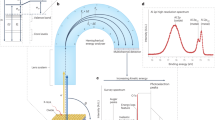Abstract.
In the pursuit of an understanding of complex surfaces, the problem of obtaining quantitative structural information about local adsorbate geometry is especially difficult. Conventional diffraction methods rely on long-range order of the adsorbed species, rarely present in complex coadsorption systems. Elementally specific local structural probes can help, but ultimately one also requires chemical-state specificity. This can be achieved in structural methods that involve detection of photoelectrons through the well-known ‘chemical shifts’ in core-level photoelectron binding energies; specific methods of this type are scanned-energy mode photoelectron diffraction (PhD) and normal-incidence X-ray standing waves (NISXW). Recent examples of chemical-shift PhD and NIXSW applications to complex coadsorption systems and to larger molecular adsorbates demonstrate this potential.
Similar content being viewed by others
Author information
Authors and Affiliations
Additional information
Received: 28 April 2000 / Accepted: 6 June 2000 / Published online: 7 March 2001
Rights and permissions
About this article
Cite this article
Woodruff, D. Chemical-state specificity in surface structure determination . Appl Phys A 72, 421–428 (2001). https://doi.org/10.1007/s003390100755
Issue Date:
DOI: https://doi.org/10.1007/s003390100755



